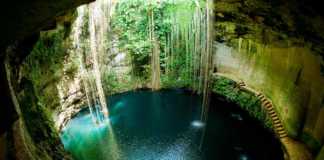Cenotes are a unique physical feature of Mexico and places near the border in Belize and Guatemala. Yucatán state has thousands of cenotes and the most cenotes in Mexico. The Chicxulub Crater was responsible for forming these unique features millions of years ago when an asteroid hit the Earth in this location. Other Mexican states containing cenotes include Quintana Roo, Chiapas and Campeche.
Cenotes are highly protected and revered sites with a delicate ecosystem. They played an important part in ancient Mayan culture, and many cenotes contain underwater archaeological sites. To keep these sites pristine, visitors are not allowed to use sunscreen, other chemicals or fragrances on their bodies. Some cenotes have showers for people to use before entering the water in the cenotes. Many have strict rules about what you can bring into the area.
Contents
- Cenotes in Mexico
- Types of Cenotes In Mexico
- Tips For Visiting A Mexican Cenote
- Cenote Tours
- Cenotes In Yucatan
- Cenotes in Chiapas
- Cenotes in Campeche
Cenotes in Mexico
Types of Cenotes In Mexico
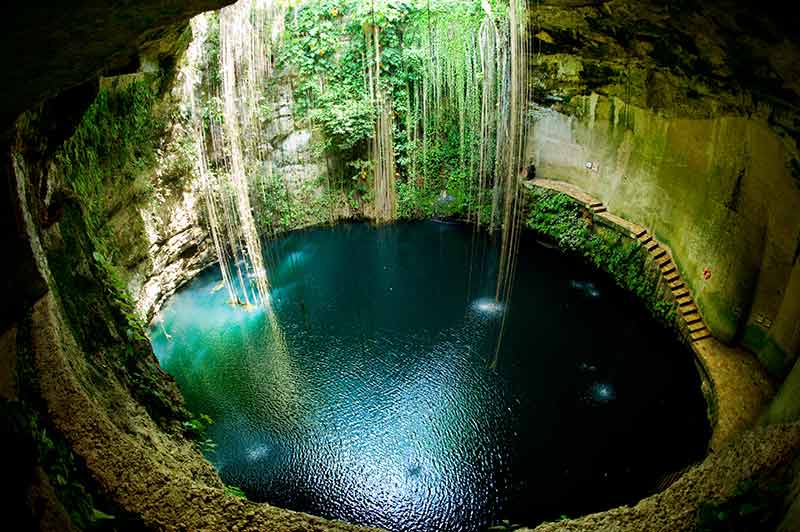
There are four types of cenotes in Mexico:
- Cavern cenotes are the youngest, and many remain hidden or closed to the public. This type of cenote played an important role in ancient Mayan culture.
- Semi-open cenotes are the second-youngest type of cenote. Some of these are connected to other cenotes by underground tunnels, sometimes hundreds of meters long.
- Open cenotes are one of the oldest cenotes where rock formations no longer cover the water.
- Ancient cenotes are the oldest type and no longer look like cenotes but more like open-air lagoons.
Tips For Visiting A Mexican Cenote
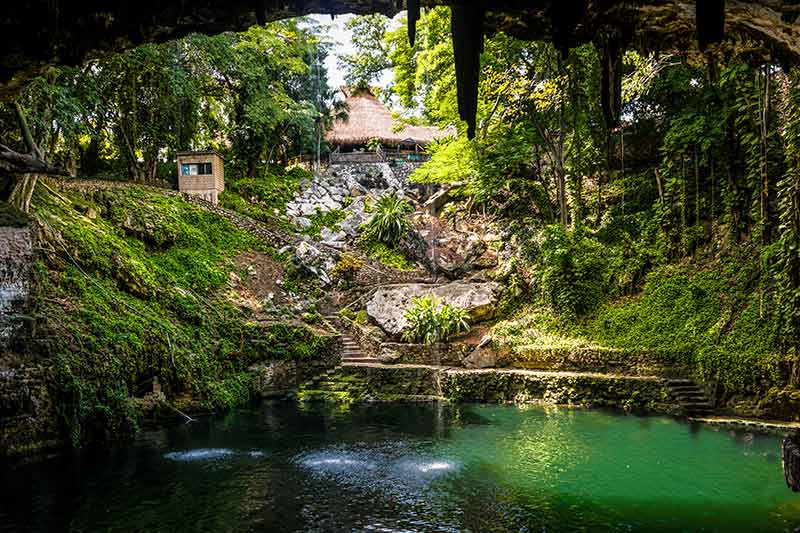
- Sunscreen, body creams, makeup and insect repellant are not allowed at any cenote and must be washed off before entering the water.
- You can rent snorkelling, diving, and kayaking equipment at many cenotes.
- Wear non-slip water shoes.
- Bring a diving mask to more fully enjoy viewing the cenote.
- Avoid touching any rock formations like stalactites and stalagmites.
- Never hang on tree roots dangling from above.
- Many privately-owned cenotes only accept cash as payment.
Hundreds of cenotes throughout the Yucatán Peninsula are open to the public. Several are well-advertised in resort hotels and draw thousands of visitors each year, making these cenotes crowded and more like a water park than an incredible part of nature and history.
For visitors wishing to experience these unique features, early arrival is recommended for the most well-visited cenotes in the region. Because cenotes contain important cultural and historical significance for the local people, visitors must respect the rules and recommendations to enjoy these places for many generations to come.
For more adventures in Mexico, read:
- 20 Things To Do In Tijuana
- 20 Things To Do In Merida
- 20 Things To Do In Ensenada
- 20 Tulum Day Trips
- Where To Stay In Tulum
- 20 Amazing Tulum Resorts
- 20 National Parks In Mexico
- 20 Day Trips From Mexico City
- 20 Day Trips From Cancun
- 20 Things To Do In Cancun With Kids
- 20 Things To Do In Mexico City At Night
- 20 Things To Do In La Paz
- 20 Things To Do In Monterrey Mexico
- 20 Things To Do In Acapulco
- 20 Things To Do In Chihuahua
- 20 Things To Do In Puerto Vallarta
- 20 Things To Do In Oaxaca
- 32 States In Mexico
- 20 Cities In Mexico
- 20 Islands In Mexico
- Where To Stay In Mexico City
- Everything You Need To Know About Lucha Libre (Mexican Wrestling)
- 15 Things Mexico Is Famous For
- 20 Overwater Bungalows and Beachfront Villas In Mexico
- 20 Famous Landmarks in Mexico
- 20 Best Beaches in Mexico
- 20 Ways To Spend Christmas in Mexico
- 10 Things To Do In Baja California
- The Wonder of Chichen Itza
- When Is The Best Time To Visit Mexico?
- A Guide To Las Grutas De Tolantongo
- A Guide To Valle De Bravo
- 20 Best Cenotes In Mexico
- 20 Interesting Mexican Traditions
- 20 Mayan Ruins In Mexico
- 20 Things To Do In Veracruz
- 25 Things To Do In Guadalajara
- 20 Mexican Cocktails and Drinks
- 20 Things To Do In Mazatlan
- 20 Things To Do In Cancun
- 20 Things To Do In Los Cabos
- 20 Things To Do In Nayarit
- 20 Things To Do In San Luis Potosi
- 20 Things To Do In Baja California Sur
- 20 Things To Do In Hidalgo
- 20 Things To Do In Guanajuato City
- 20 Things To Do In Zacatecas, Mexico
- 20 Things To Do In Huatalco, Mexico
- 20 Things To Do In Bacalar, Mexico
Cenote Tours
Mexico can be a little confusing to explore on your own and the most relaxing way to visit cenotes are on a tour.
Full-Day Rio Secreto Small Group Tour is a full-day tour to a popular ancient Mayan cave. Skip the line and book this tour to explore the secret river’s underground caves and waterways.
Riviera Maya/Cancun Cenote Tour – this tour combines exploring the pyramids and temples of Chichen Itza, a walking tour of historic Valladolid and a swim in a cool underground cenote.
Four Cenotes Adventure Tour – when all you want to do is spend the day swimming and snorkelling in a cenote. This adventure takes you to four cenotes near Tulum.
Hubiku Cenote and Chichen Itza – Visit the Hubiku cenote and Chichen Itza in one day.
Cenotes In Yucatan
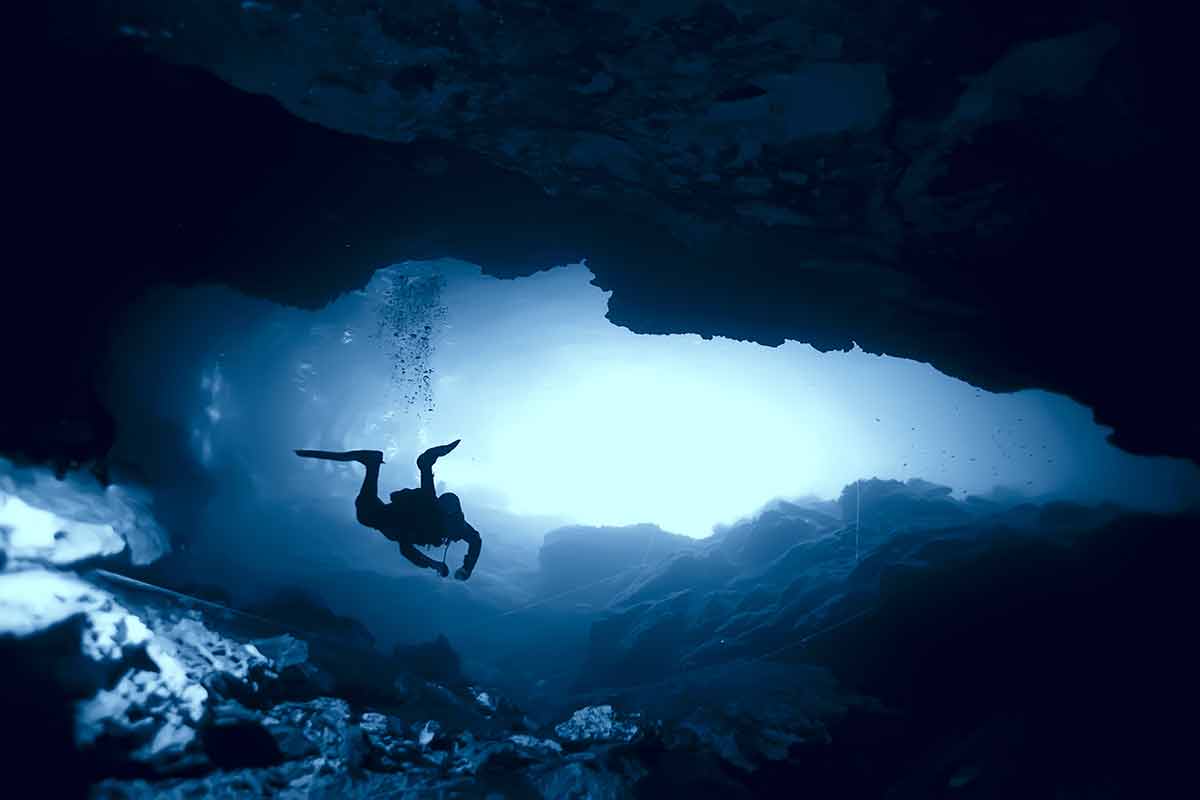
1- Cenote Xlacah
Cenote Xlacah is at the heart of Mayan culture, the ancient city of Dzibilchaltún.
This important archaeological site contains a museum, pyramids such as the famous Templo de las 7 Muñecas, many other stone structures and the Cenote Xlacah.
The cenote itself contains archaeological artifacts that can only be reached by divers who venture into the deepest waters of Xlacah.
Visitors to the cenote typically relax in the clear, shallow waters of the open cenote.
Tiny fish swim around in the shallow water and eat the dead skin cells from swimmers’ legs.
Water lilies fill the shallow water in the centre of the cenote.
This unique site provides a full day of activities for visitors to the area who are interested in learning about and experiencing ancient Mayan culture and swimming in a beautiful cenote.
Cenote Xlacah is at Zona Arqueológica de Dzibilchaltún Dzibilchaltún, 97305 Mérida, Yucatan, Mexico.
2- Cenote San Pedro Cholul
The San Pedro Cholul cenote is one of more than sixteen publicly-accessible cenotes located in the town of Homún, not far from Mérida.
Dive, swim or snorkel the 10m deep, clear, blue waters of this cavern-type cenote.
This cenote is known for the painted hands preserved on the walls, dating back to the Mayan period, and has only been open to the public since 2018.
There are toilets and showers at the cenote, and guides in the town can help visitors find the San Pedro Cholul cenote and others in the area.
The proximity of these cenotes to each other means that you can visit several in one day, each of them some unique characteristic different from the rest.
Cenote San Pedro Cholul is at Km. 1 Carretera a Conkal, Mérida, Yucatán. Entry $20.
3- Cenote Bebelchen
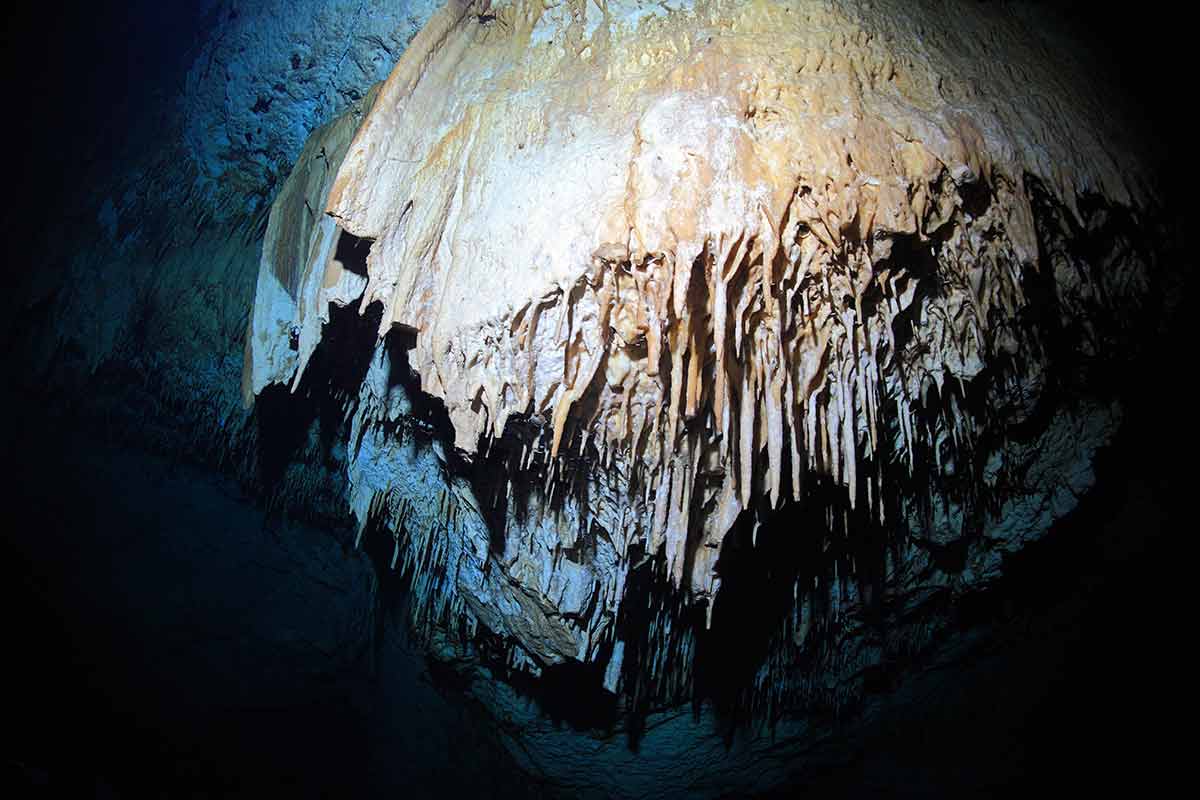
Bebelchen is off the main road in a jungle near Hocaba, more than an hour from Mérida.
This cavern-type cenote is small, but it does not see as many tourists as some of the larger cenotes because it is relatively remote.
Stalagmites and stalactites dominate the landscape of the cenote, and the deep waters are a clear, crystal blue.
Life vests must be worn because there is no shallow water and bring your own snorkelling or diving equipment, but kayaks are available for rent.
There are public bathrooms, dressing rooms, showers, and a small restaurant selling regional food.
Cenote Bebelchen is at Sanahcat, Yucatan, Mexico.
4- Cenote Cuzamá
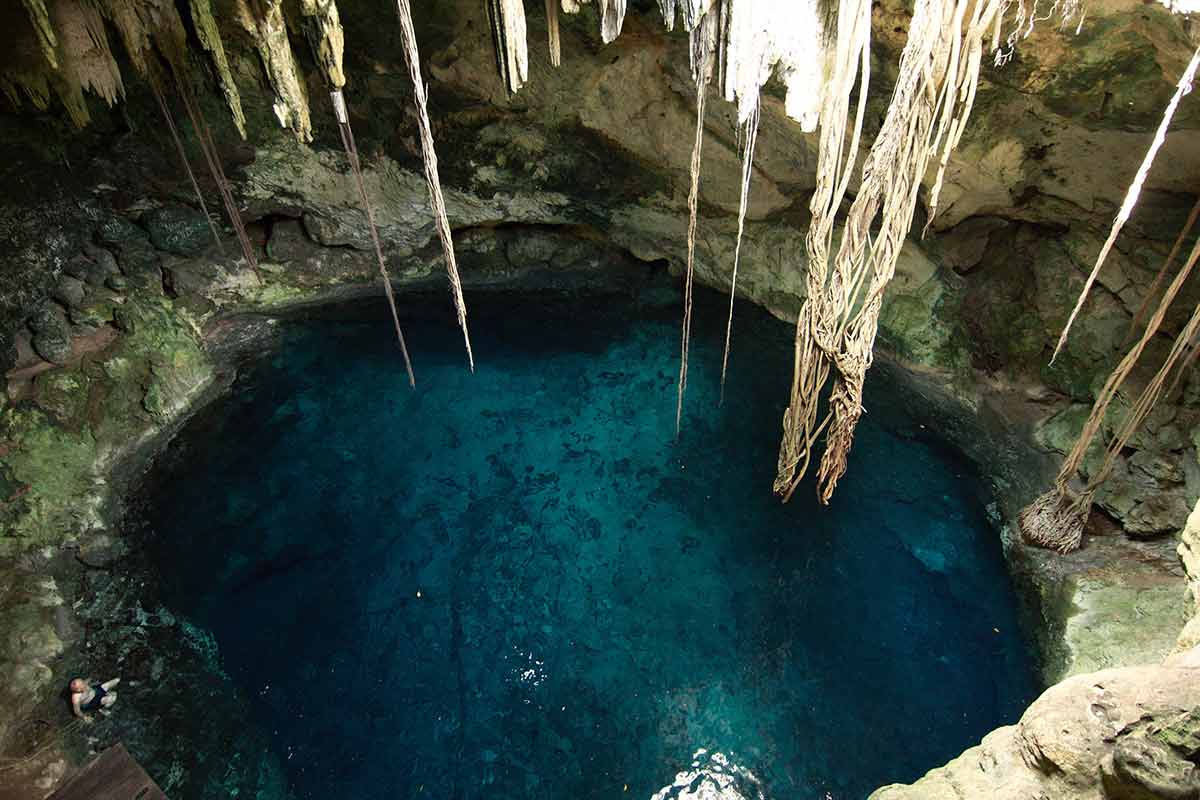
Cuzamá contains three cenotes – Ucil, Chak-Zinik-Ché, and Bolom-Chojol – located 26 km from Mérida.
There are restrooms on-site, and horse-drawn wagon tours are available for guests to the three cenotes.
Regional Yucatecan-type foods are available for purchase, and green spaces with a picnic area are open to the public.
Cenote Ucil
Cenote Ucil is a cavern cenote and the smallest cenote at this location. It has startling clear blue waters up to 17m deep.
It is filled with stalagmites and stalactites and liti up using artificial light.
Cenote Chak-Zinik-Ché
This is a semi-open cenote with clear, blue water 30 m deep.
Long tree roots and stalactites hang down from the ceiling.
It’s an ideal cave-diving location and a popular spot for swimming and snorkelling.
Cenote Bolom-Chojol
Cenote Bolom-Chojol is a semi-open type of cenote, 35m deep.
You descend a steep, wooden staircase to the transparent, blue waters below.
The large cavern is well-lit by the nine holes in the cenote’s ceiling and is a popular place to take photos.
5- Cenote Papakal
Cenote Papakal, also called Paraíso Papakal, is on the road between Cuzamá and Homún, a 30-minute drive from Mérida.
Because of its location, it is one of the least-visited cenotes in Yucatán, making it a favourite of those wanting to get away from the crowds.
Papakal is a cavern-type cenote with a maximum depth of 31 m and three tunnels perfect for cave diving that branch off the main cavern.
Bats flit above the water in this peaceful and silent cenote.
The turquoise-coloured water is crystal clear, and rock columns, stalagmites, and stalactites fill the cavern, making it a wondrous sight.
Camping and cabins are available at this cenote and bathrooms and dressing rooms.
Life vests are recommended, as only a tiny area is shallow, but hiring a life vest is not included in the entry fee.
Cenote Papakal is at Eknakán, Cuzama, Yucatan, Mexico.
6- Cenote Xkeken
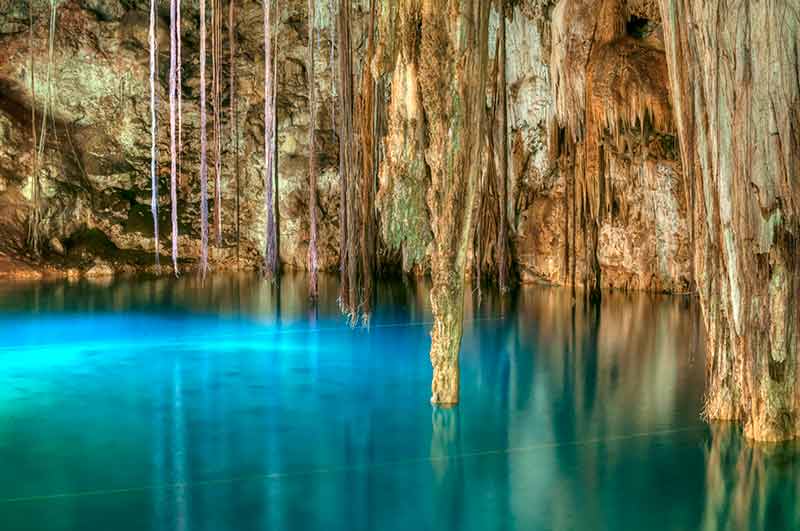
Cenote Xkeken (or Cenote Dzitnup) is a cavern-type cenote near Cenote Samula and about a 40-minute drive from Chichen Itza.
These two cenotes are connected underground through water-filled tunnels.
Tree roots and stalactites hang down from the cave’s ceiling, and a hole in the top allows sunlight to filter down inside.
The cenote is relatively small, with water depths up to 20 m deep.
Bathrooms, showers and dressing rooms are available on-site, and life jackets can and should be rented, especially for children.
Food is available for purchase at this cenote, and there’s a picnic area set up for families.
Cenote Xkeken is popular for visitors who want to swim because it’s patrolled by lifeguards.
Cenote Xkeken is in Dzitnup, Yucatán, Mexico.
7- Cenote Palomitas
Cenote Palomitas is near Valladolid in Yalcobá, not far from the pyramid attraction of Chichen Itza.
It’s a cavern-type cenote with stalactites hanging from the ceiling towards the clear, blue water of this 45 m deep cenote.
Natural openings in the ceiling allow sunlight to shine on the water, while artificial lighting inside the cavern helps to illuminate the electric-blue colour of the water.
Bathrooms and dressing rooms are available at this site, and you can rent life vests and kayaks.
There’s a local restaurant serving Yucatecan food here too.
Cenote Aguadulce is 100 m from Palomitas, so it is easy to visit both cenotes together.
Cenote Palomitas is not as well-known as many other cenotes in this area, so fewer people means that visitors seeking a peaceful place will be able to enjoy this cenote.
Cenote Palomitas is in Yalcobá, Yucatan, Mexico.
8- Cenote Noh Mozón
Cenote Noh Mozón is a semi-open cenote located approximately 56 km from Mérida.
The transparent, blue water and depths up to 45 m make this a popular place for swimming, snorkelling and diving.
Camping, rustic toilets, and showers are available, and even though this cenote is stunningly beautiful, its remoteness has kept it from being discovered.
Cenote Noh Mozón is at 97823 Yucatan, Mexico.
9- Cenote Kin Ha
Cenote Kin Ha is a cavern-type cenote in the Cenotes Kin Ha Adventure Park near Puerto Morelos.
This is a popular destination, and the park has many activities for families, including horseback riding and ATV tours, ziplining, and swimming in two cenotes.
This park is in a lush jungle setting, and there’s a restaurant at the cenote.
The Kin Ha cenote is the primary attraction because the ancient Mayans considered this cenote to be the gateway to the underworld.
You can rent life jackets, and there are restrooms with showers and changing here.
Kin Ha has clear, blue water plunging 40m deep adjacent to a semi-open cenote called Blanca Flor.
This park draws many international visitors who book into a resort nearby, which means it can get crowded.
The best time is as soon as it’s open first thing in the morning before the crowd arrives.
Cenote Kin Ha is at Cenote Kin ha, 77501 Puerto Morelos, Quintana Roo, Mexico.
10- Cenote Chac Mool
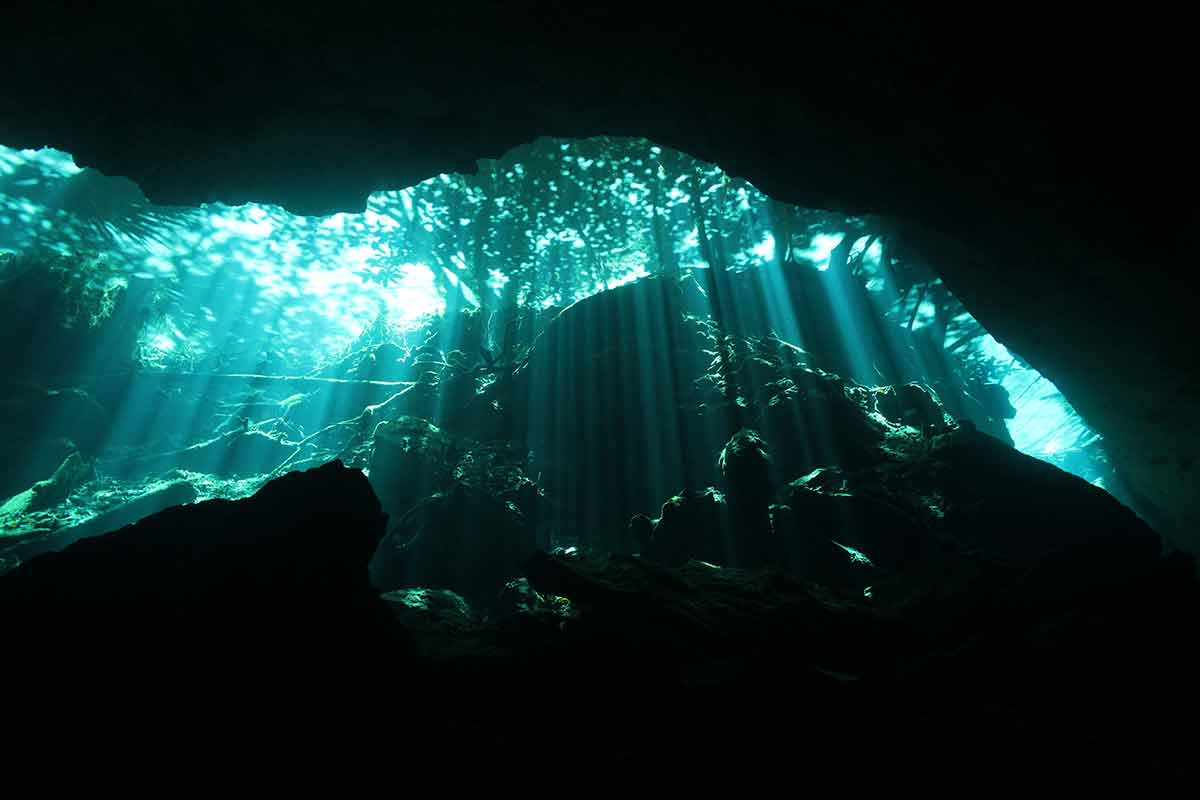
Cenote Chac Mool is a cavern-type cenote that is a perfect diving location with a depth of 14 m and three caverns to explore.
The visibility is excellent, and the rock formations are beautiful.
In one of the caverns, the sun shines through an opening in the ceiling, illuminating the water and displaying the unique effect where saltwater and freshwater mix together.
Turtles, crayfish, and many fish species can be found in this cenote.
Cenote Chac Mool is on the Route of Cenotes near Playa del Carmen on Highway 307 in Quintana Roo.
11- Cenote Siete Bocas
Cenote Siete Bocas (Seven Mouths) is a cavern-type cenote located on the Route of Cenotes in the Riviera Maya.
It’s one of the most expensive cenotes in the area because of its popularity.
The name “Seven Mouths” comes from the seven holes in the cavern ceiling that allow sunlight to illuminate the cenote.
You can climb down some of these holes into the cenote and there is one particular hole that’s a great place to jump into the water from above.
Tree roots and stalactites reach down to the water as swimmers and snorkelers navigate the clear, blue waters.
You can rent life vests, but other services are extremely basic. Rustic bathrooms and changing rooms with showers are available on-site, and there’s a picnic area.
Siete Bocas is at Cenote de 7 bocas, Puerto Morelos.
12- Chilam Balam
Cenote Chilam Balam is a cavern-type cenote located in the Riviera Maya.
You can only reach the emerald-green waters of this cenote with an off-road vehicle by driving through the jungle.
At the cenote, you can swim, snorkel and dive into the clear water or relax on the stone platform in the centre where tree roots reach down into the water.
As this cenote is more challenging to get to, it’s best to join a guided tour where snorkelling and diving gear is all organised.
Chilam Balam is at Ruta de los Cenotes, Puerto Morelos, Quintana Roo.
13- Río Secreto
Cenote Río Secreto is a unique cenote experience near Playa del Carmen.
This cavern-type cenote is best explored with a guide, and some specialised equipment such as helmets with headlamps and a wetsuit is necessary to explore the caverns comfortably.
Everyone has to shower before entering the cavern.
Once inside, you can hike, climb and swim through transparent pools of water as they wind through the cavern complex.
Beautiful landscapes of stalagmites and stalactites fill the caverns with their incredible formations.
These formations and caverns are usually underwater and only seen by divers in most other cenotes.
It would help if you were mobile and reasonably fit and children under four are not permitted.
Cenote Río Secreto is at Carretera Federal Libre Chetumal – Puerto Juárez Km 283.5, Ejido Sur, 77712, 77712 Playa del Carmen, Q.R.
14- Skull Cenote
Cenote Calavera is a cavern-type cenote near Tulum.
The unique feature of this cenote is you can enter the cenote through one of the ‘eyes’ or climb down a ladder into the water through the ‘mouth’.
It is a large cavern with depths of 19 m and clear, blue-green water ideal for swimming, snorkelling and diving.
It’s an amazing experience floating on your back and gazing up at the cavern ceiling to admire the pattern of holes that this cavern was named for – Calavera or Skull Cavern.
There’s a rustic bathroom at this cenote, but not much else.
It’s an ideal cenote for adventurous travellers wanting to escape the crowds, and it’s not too far away from several other cenotes in the area.
Cenote Calavera is at Carretera Tulum Coba Km 1.7, 77796 Tulum, Q.R.
15- Dos Ojos
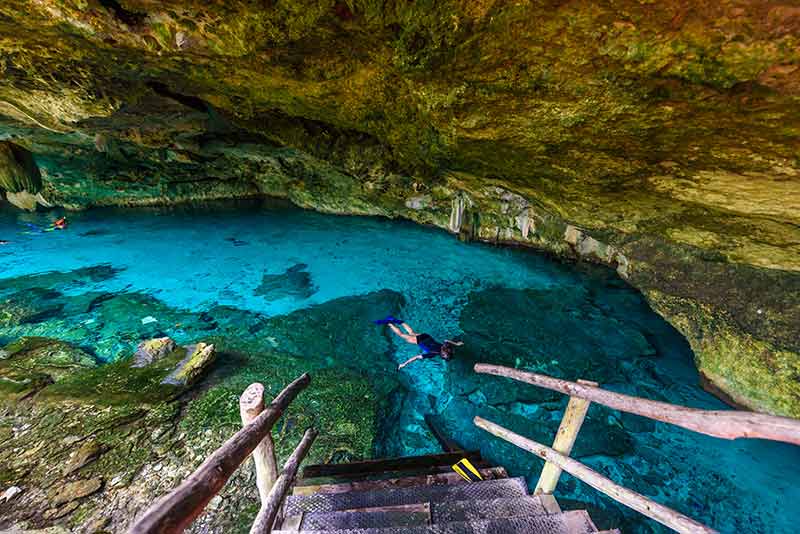
Dos Ojos Cenote in Tulum is one of the most famous cenotes in Mexico.
As it’s only a short drive from Tulum, it attracts visitors from all over the world.
There are two eyes or caves to swim at this cenote.
One is more open than the other, but both contain calm, clear, blue water.
Swimming, snorkelling and diving are all popular activities at this cenote.
A life vest is included in the entrance ticket price, but snorkels and fins are extra. You can buy food from local stalls or bring your own.
Dos Ojos Cenote is at Cenote Jaguar Rd, 77780 Tulum, Quintana Roo.
16- Cenote Azul
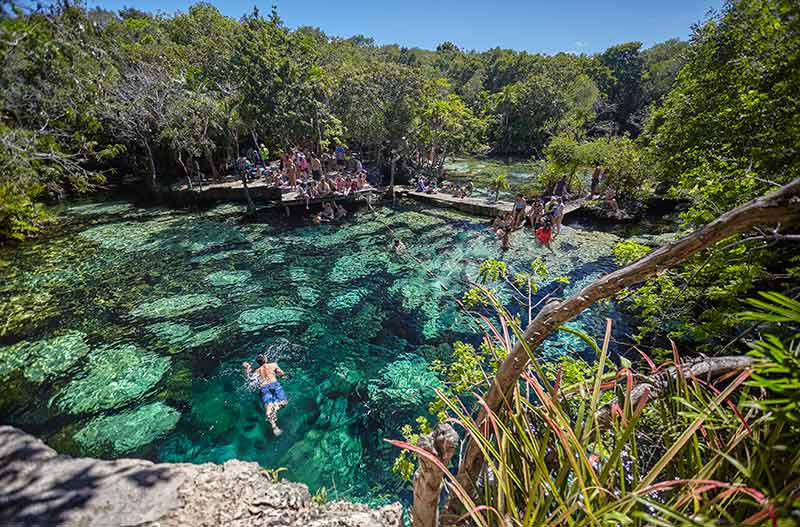
Cenote Azul is another famous cenote in Quintana Roo because of its proximity to Playa del Carmen.
Because of its size and variety of pools, visitors can spread out in the different pools of the cenote.
Shallow pools are fantastic areas for families to hang out and swim or snorkel, while deeper pools are ideal for scuba divers.
There’s a six-metre diving platform for brave swimmers.
The clear, blue water filled with small fish, surrounded by lush trees and vegetation filled with iguanas and colourful birds, all contribute to a fun all-day activity in paradise.
Cenote Azul is between Playa del Carmen and Tulum at Riviera Maya, Carr. Cancún – Tulum Km 266, 77734 Quintana Roo.
17- Casa Cenote
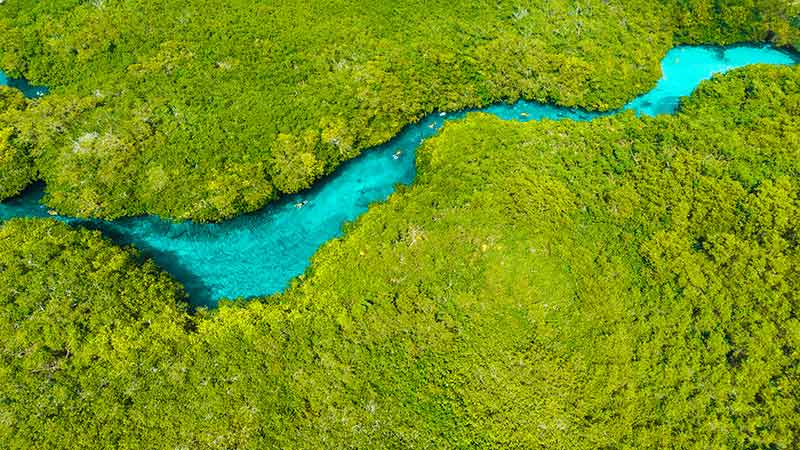
The Cenote Manatí, also called Casa Cenote, is an open cenote 40-minute drive from Playa del Carmen, and there’s a 20-minute walk from the road to the entrance.
Mangroves frame the blue water of this cenote, and a small alligator named Panchito is often spotted sunning itself or swimming in the cenote.
This cenote contains salt and fresh water and is only a few steps away from a beautiful Caribbean beach.
You can rent snorkelling and kayaking equipment on-site, and bathrooms and changing rooms are available.
There is a restaurant that is open all day located near the cenote.
This paradise location may be rustic, but you won’t be disappointed by the beauty of the cenote and the adjacent beach.
Casa Cenote is at Carretera Cancun – Tulum Km. 246, Tankah Mz. 3, 77780 Tulum, Quintana Roo.
Cenotes in Chiapas
18- El Chukumaltik
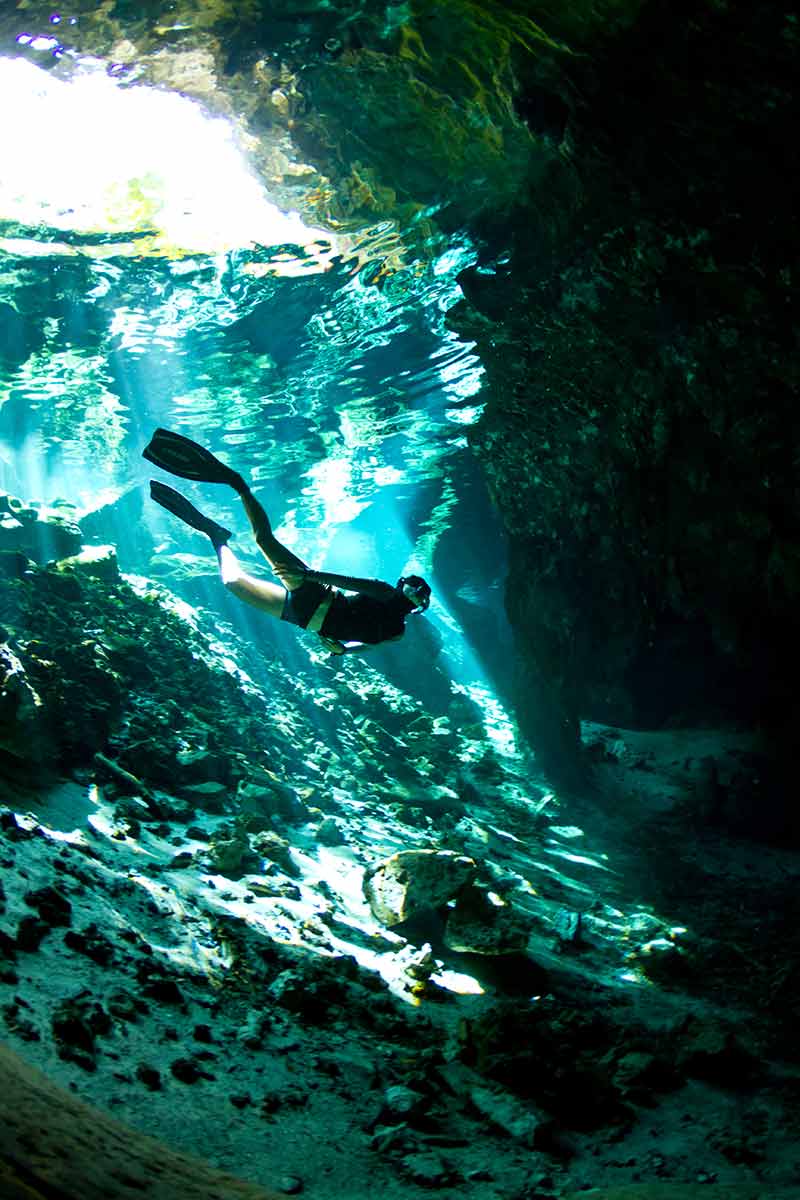
El Chukumaltik in Chiapas has earned the reputation as the most beautiful cenote in Chiapas.
Measuring 200 m across and 70 m deep, it is popular for diving.
The crystal-clear waters of this cenote allow visibility up to 40 m deep.
Divers will have a wonderful time underwater searching for the statue of la Virgen de Los Dolores, secret caves, sulphur chimneys and deposits of quartz.
Cenotes in Campeche
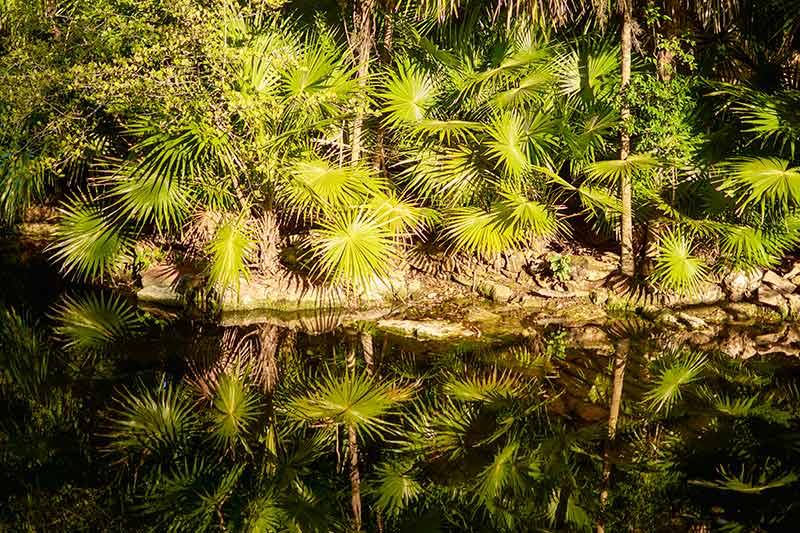
19- Cenote Azul in Miguel Colorado
Cenote Azul in Miguel Colorado in Campeche is an open-type cenote surrounded by lush jungle vegetation.
It has a 250 m diameter and is a popular place for kayaking, swimming, hiking and ziplining.
The entry price includes life jackets, which are recommended for less-skilled swimmers swimming among the schools of fish in the water.
From Cenote Azul, hire a guide and go on a walking tour to visit two more cenotes – Los Patos, which is closed to the public, and K41, hidden in the jungle.
20- K41
Cenote K41 is named for its location at kilometre 41 on the train tracks that run right past the cenote.
The blue-green waters of this cenote are an impressive 115 m deep.
This open-type cenote is famous for the thousands of bats that live here and dramatically exit the cenote at dusk.
Hire a guide to go on a sunset hike to view this spectacular show.
Plan Your Trip

Rent A Car – Find the best car rental rates at Discover Cars. They compare car hire companies to provide you with the best deal right now.

Find A Hotel – If you’re curious about this article and are looking for somewhere to stay, take a look at these amazing hotels.
